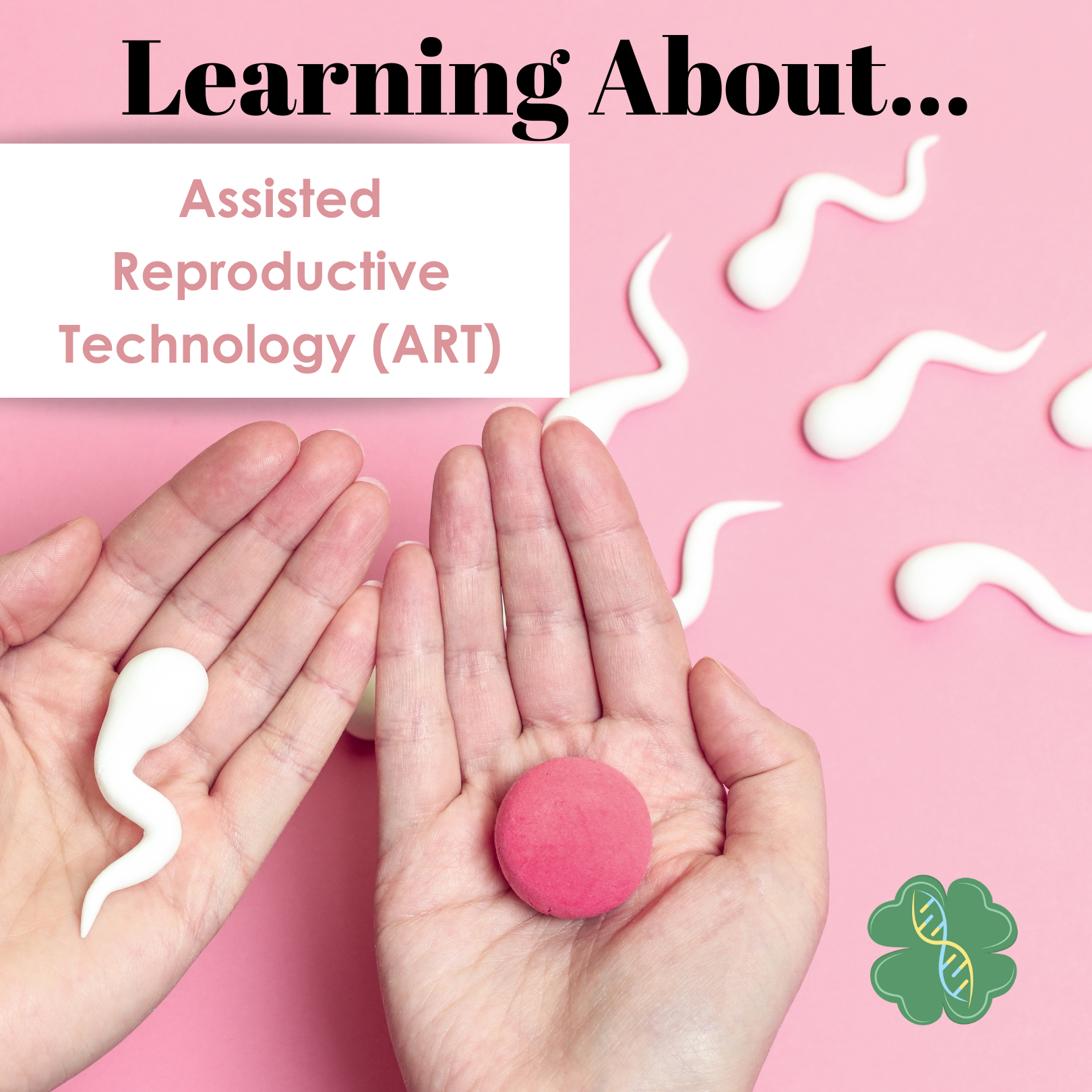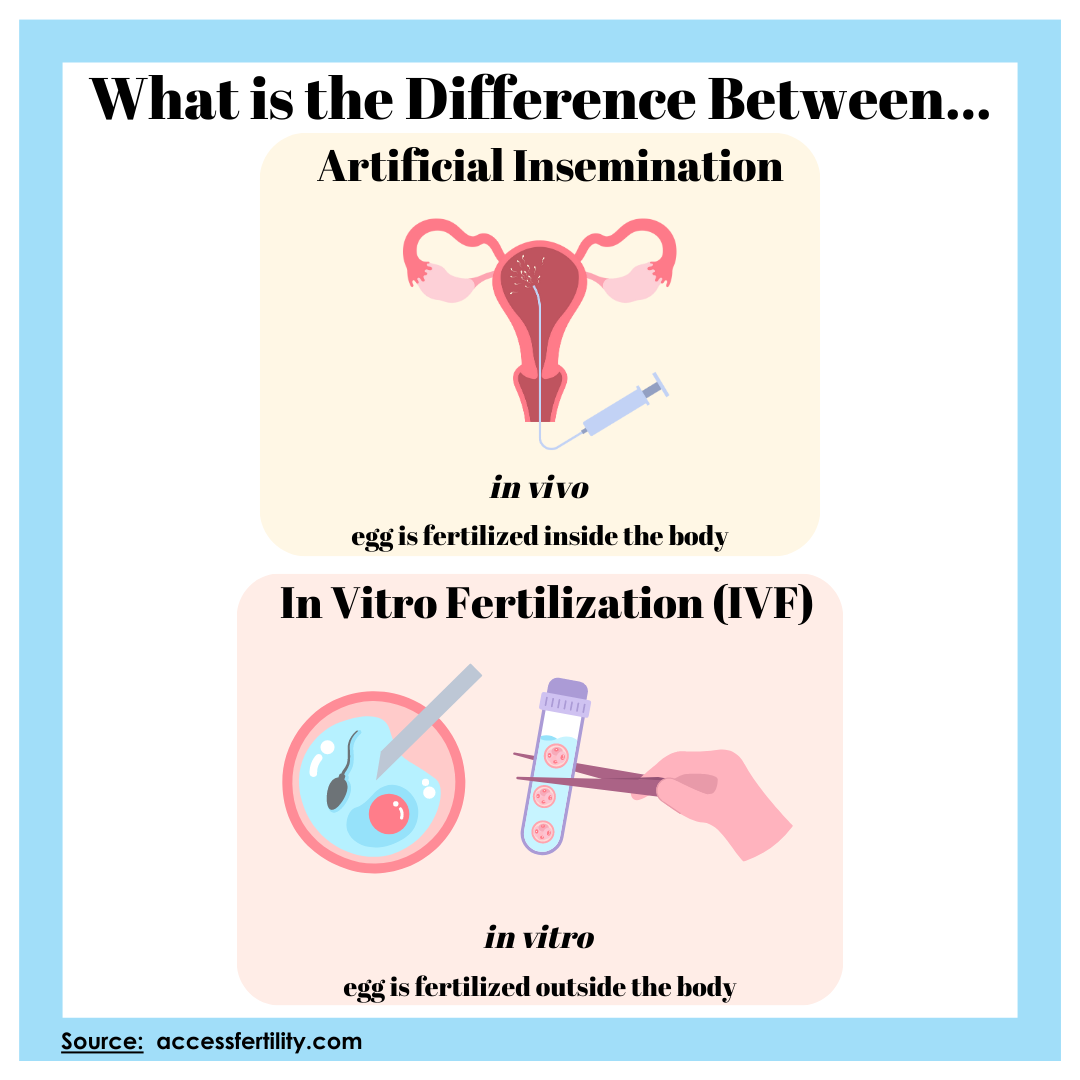This page was written by Manaswini Krishnakumar in collaboration with Jessie Chen, Orin Whitby, and Rachel Baer MSc with review by Andy McCarty, MS, CGC
Understanding Options for Assisted Reproductive Technologies
What is Artificial Reproductive Technology (ART)?
Assisted Reproductive Technology (ART) is a group of processes of treatments used to achieve pregnancy. ART is one of the most common treatments for infertility. The course of action to address each person or couple’s cause of infertility is determined by fertility specialists based on the specific circumstances. All treatments include the handling of eggs and/or embryos. There are other non-invasive treatment options that are not considered ART, like timed intercourse, which is often the starting point for those attempting pregnancy and consists of planning intercourse around ovulation. Another non-ART method, that may or may not be partnered with ART, is medication based and is called Ovulation Induction. This uses medications to stimulate the release of eggs from the ovary to allow for natural fertilization during intercourse (7).
Brochures written by Manaswini Krishnakumar with Design by Nira Johnson, MSc, GC; Reviewed by Andy McCarty, MS, CGC, and Rachel Baer, MSc.
What Types of ART Treatments Exist?
Eggs are the female reproductive cells and sperm are the male reproductive cells. When the egg and sperm cells fuse, they form an embryo. The following are different types of Assisted Reproductive Technology:
In-Vitro Fertilization (IVF): A process in which an egg and sperm are combined in a laboratory to facilitate fertilization outside the uterus.
Traditional IVF: incubating an egg and many sperm cells together to allow for natural fertilization.
Intracytoplasmic Sperm Injection (ICSI): A single sperm is injected into the center of an egg cell. ICSI is a form of IVF that can be paired with other IVF or FET treatments to achieve a pregnancy.
Intrafallopian Transfer: Fallopian tubes are a pair of tubes attached to the uterus, one on each side, where sperm and egg meet during typical conception. The following are the types of Intrafallopian Transfers:
Gamete Intrafallopian Transfer (GIFT): The direct transfer of sperm and eggs into the fallopian tube. Fertilization takes place inside the tube(6).
Zygote Intrafallopian Transfer (ZIFT): Specialists stimulate egg formation and collect the eggs using IVF methods and mix the eggs with sperm in the lab before returning fertilized eggs or zygotes to the fallopian tubes(6).
Pronuclear Stage Tubal Transfer (PROST): PROST involves the transfer of a fertilized egg to the fallopian tube before cell division occurs.
Frozen Embryo Transfer (FET): The frozen embryos made using IVF are thawed and placed inside the uterus. The IVF fertilized embryos can be stored in freezing conditions, known as cryopreservation. During a FET, the embryos are thawed and placed inside the uterus during the implantation window(5).
Third-Party ART:
Donations: Egg and/or sperm donations or whole embryo donations to an individual or couple(5).
Surrogate and Gestational Carriers: When an individual who is not an intended parent is inseminated with sperm or an embryo that is implanted into their uterus to be carried for the intended parents until birth.
Who Commonly Uses ART?
Individuals or Couples Who:
Are the same sex assigned at birth and want a biological child
Have trouble conceiving a child after actively trying to conceive for over 12 months
Are carriers or affected by genetic disorders
Have had multiple pregnancy losses, unsuccessful pregnancies, child or infant loss
Are assigned female at birth, aged 35 or older, want to become pregnant, and hope to reduce their increased risk for their future child being born with certain chromosomal abnormalities.
Are assigned male at birth and are 40-50+ years old concerned about decreased fertility and increased risk for atypical sperm associated with increased age:
Oligospermia: Most significant; low sperm concentration
Asthenospermia: Poor sperm motility
Teratospermia: Abnormal sperm morphology (1).
How Can Genetic Counseling Help those Considering or Undergoing ART?
Who Can Benefit from Preconception Genetic Counseling:
Couples or individuals who have had multiple pregnancy losses or infertility with no known cause
2SLGBTQIA+ individuals who want to understand their reproductive options
Those with a family history of genetic disorders
Those who have been found to be carriers for a genetic condition after receiving results from carrier/genetic testing
Those from certain ethnic backgrounds with increased carrier frequency for specific disorders
Individuals who have a desire for detailed information regarding their genetic testing options
Preimplantation Genetic Testing (PGT) of embryos for chromosomal changes and genetic changes.
Who Can Benefit from Prenatal Genetic Counseling:
Those who have received an atypical ultrasound during prenatal scans
Those who have received unexpected prenatal blood results
Those who have received a high-risk report after undergoing Non-Invasive Prenatal Screening (NIPT/NIPS)
Learn more about prenatal screening and testing here.
Citations:
Harris ID, Fronczak C, Roth L, Meacham RB. Fertility and the aging male. Rev Urol. 2011;13(4):e184-90. PMID: 22232567; PMCID: PMC3253726.
Walker MH, Tobler KJ. Female Infertility. [Updated 2022 May 26]. In: StatPearls [Internet]. Treasure Island (FL): StatPearls Publishing; 2022 Jan-. Available from: https://www.ncbi.nlm.nih.gov/books/NBK556033/
Carson SA, Kallen AN. Diagnosis and Management of Infertility: A Review. JAMA. 2021 Jul 6;326(1):65-76. doi: 10.1001/jama.2021.4788. PMID: 34228062; PMCID: PMC9302705.
Leslie SW, Soon-Sutton TL, Khan MAB. Male Infertility. [Updated 2022 Nov 28]. In: StatPearls [Internet]. Treasure Island (FL): StatPearls Publishing; 2022 Jan-. Available from: https://www.ncbi.nlm.nih.gov/books/NBK562258/
Jain M, Singh M. Assisted Reproductive Technology (ART) Techniques. [Updated 2022 Nov 28]. In: StatPearls [Internet]. Treasure Island (FL): StatPearls Publishing; 2022 Jan-. Available from: https://www.ncbi.nlm.nih.gov/books/NBK576409/
Tolu Oyelowo,Chapter 21 - Infertility,Editor(s): Tolu Oyelowo,Mosby's Guide to Women's Health,Mosby,2007,Pages138-146,ISBN9780323046015,https://doi.org/10.1016/B978-032304601-5.50022-8.(https://www.sciencedirect.com/science/article/pii/B9780323046015500228)
Ovulation Induction and Intrauterine Insemination. Yale Medicine. 2023. https://ym.care/pqm



